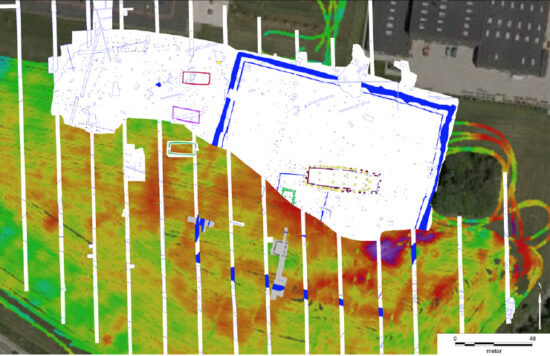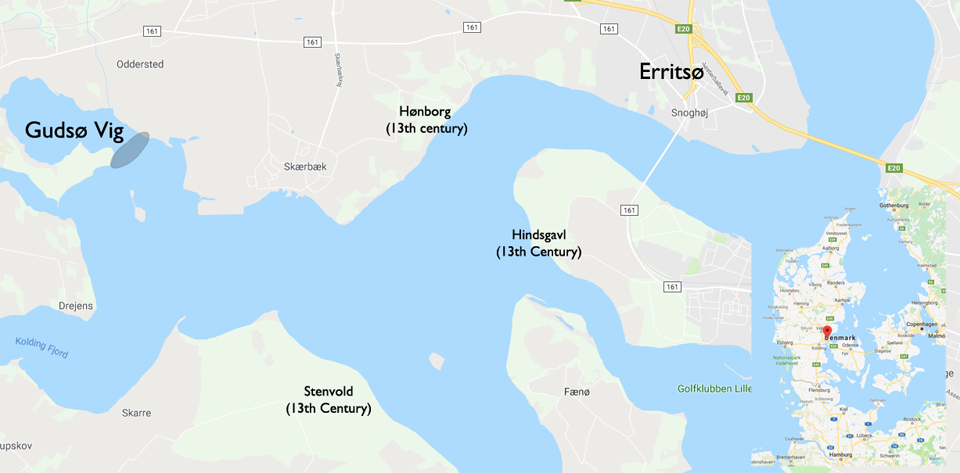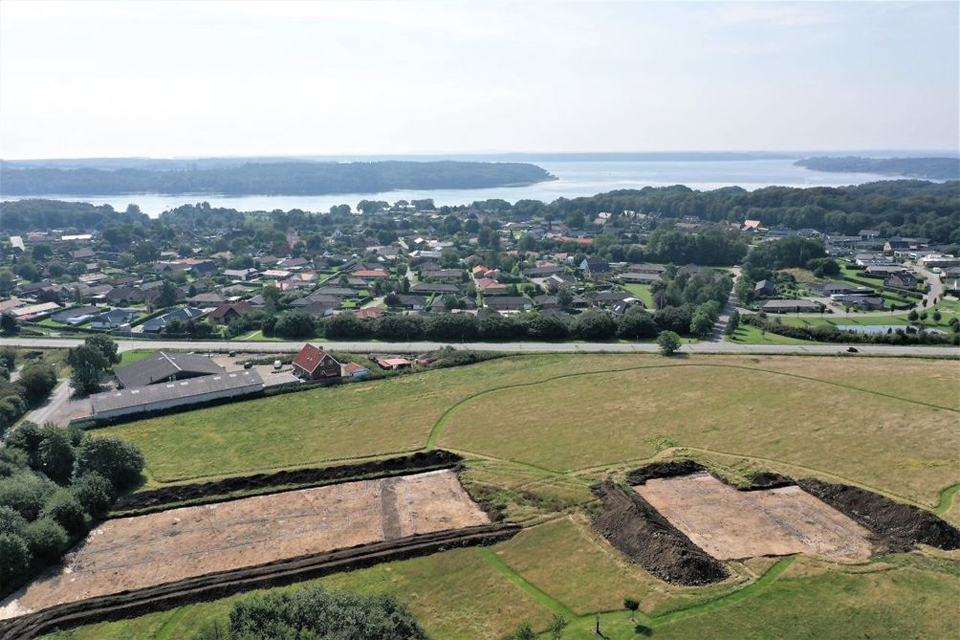Some years ago archaeologists discovered an elite residence in 8th century Jutland. New excavations recently uncovered yet another magnificent hall. Might this be Godfred’s and his ancestor’s?

Erritsø is located at a headland overlooking a crucial junction at the narrow end of Lillebælt, the sound between Jutland and the island of Funen. Located c. one kilometre from the seashore it continues to touch upon one of the busiest traffic corridors joining the east and the west of Denmark as well as opening up towards the north. Strategically, the area continued to be of utmost importance during the Middle Ages, when it served as the southern outpost bordering the duchy of Schleswig, Holstein and further south Saxony. Place-names also indicate the military and strategic importance of the place.
Excavations from 2006 – 07 revealed the outline of a great hall measuring 34 – 39 x 12 metres. Constructed with two rows of roof-supporting posts and slightly curved walls, the hall was also supported from the outside by slightly inclining posts. The inner posts were solid and buried deep into stone-packed holes. The hall, which was replaced once, could be dated to c. 700-850. Three entrances were identified, one of which served as a unique entrance into a smaller enclosure with a smaller, though no less impressive building.
The hall with its adjoining “annexe” (temple) was built inside a moated enclosure measuring 110 x 110 metres. The V-shaped ditch was ca. one to two metres deep and one and a half to three metres wide and had been dry. Along the inner side of the trench, the enclosure was fenced off with a manned palisade. Outside the moat, the archaeologists found two pit-houses as well as remains of other smaller buildings, workshops etc. The layout of the residence looked at this point somewhat like other elite residences from the same period at Tissø and as Lejre. It seems as if the layout at Erritsø conformed to a predominant model. It appears this was how a royal or elite residence in the early Viking Age should look.
At the time of the first excavation, the site was surveyed with metal-detectors. Yet, the result was not impressive. A single Square brooch with animal style B2 from the 7th century fell neatly into the early time-frame of the elite residence.
Topography and Place-names
The narrow Lillebælt was formed during the late Ice age when the ice melted and bored its way through and beneath the cliffs, leaving a somewhat dramatic landscape. The elite residence at Erritsø was constructed on top of one of the highest point in this landscape. From here, an excellent overview allowed the monitoring of ships arriving from the south as well as land traffic crossing east-west to and from Funen.
A preliminary analysis of pollen found in the moat indicates the area was devoid of trees and foliage allowing for a free view down into the Belt. It has been possible to register ships sailing up through the Belt and heading for a natural harbour at Gudsø Vig, an inlet to the south. Earlier, archaeologists found underwater blockades outside the harbour, which were constructed in the 8th and 9th centuries.
Another indicator are the place-names referring to royal settlements – Husby, Kongsted, Herslev. Nearby Erritsø we find both a Bavn and a Bavnehøj, indicating the locations of places where fires might be lit when enemies were approaching.

New Excavations
In 2015 a survey was carried out over an area of 18.500 m2 to locate other buildings or structures nearby. Also, C14 studies were carried out, confirming the date of the complex to c. 700-850, with a dendrochronologically dated plank referring to a tree felled AD 745.
Thus, this summer, when the archaeologists returned to the site, they knew for what to look. A few days ago they published the extraordinary result of their effort: the uncovering of yet another fifty-metre long hall built of impressive solid posts able to carry the roof ca. ten metres up. As in the first compound, this large hall was also accompanied by a smaller fenced “annex”, which might perhaps be understood as a temple or sacral building. Also, the new hall seems to have been rebuilt twice, perhaps locating the construction-phase of the first hall in the 7th century.
So far, we only have tentative speculations. Might this (perhaps) earlier hall represent the first elite residence? Might the new compound be dated to the 7th century? Was this older hall later moved to the west and fitted out with a defensible structure (moat and palisade)?
So far, the only conclusion is, that the layout of the newly found hall with its outbuilding seems even more paradigmatic than the defended site. Based on the excavations, the new compound looks very much like the layout found in the early phases at Lejre.
If the early date holds, this will add substantially to our understanding of the state-structure of Denmark in the 7th and 8th century. Generally believed to be recovering from climate destruction, and perhaps the Justinian plague and migration, the peninsula and its many islands are covered by a murky veil and caught in a transition period before written sources and archaeology offer more solid evidence to the existence of proper “Danish kings” or at least warlords of some renown.
At its website the Museum claims the newly found compound might shed new and significant light on this period. One intriguing fact is that the place-name Erritsø is explained as a compound of Erik and høgh (Høj) = [Eric + hill]. Eric (or Horik) is a well-known royal name in the 9th century. Thus, from the vita of St. Ansgar we know of two Horiks, sons of Godfred, who is known from the Royal Frankish Annals to have been a mighty opponent of Charlemagne. Might the elite complex at Errritsø have belonged to these kings and their ancestors?
In its press release, the Museum tells us the excavation will continue for the next few weeks, at which point we might know some more.
The Excavations are supported by Augustinusfonden and carried out in cooperation with The National Museum of Denmark.
FEATURED PHOTO:
View from the excavated halls towards Lillebælt. Dronefoto: Esben Klinker Hansen
SOURCE:
Ny kæmpehal fundet ved Erritsø
Press-release from Vejle Museum
READ MORE:
Erritsø – A Fortified Early Viking Age Manor near Lillebælt. New investigations and research Perspectives.
By Christian Juel and Mads Ravn
In: The Fortified Viking Age. 36th Interdisciplinary Viking Symposium in Odense, May 17th, 2017. Series: Archaeological and Historical Studies in Centrality, Vol 3, 2018
Research Centre Centrum, Odense City Museums, and University Press of Southern Denmark 2018
Yngre jernalders eliteresidenser
By Kamilla Fiedler Terkildsen
In: Kuml 2018. Årbog for Jysk arkæologi. Århus Universitetsforlag.
